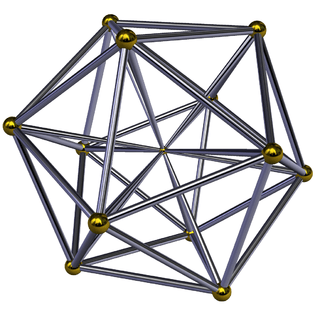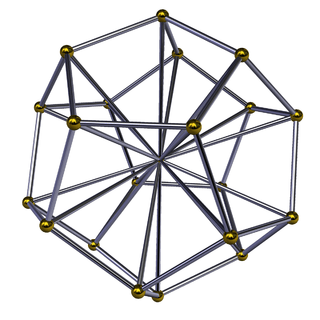Icosahedral pyramid
| Icosahedral pyramid | ||
|---|---|---|
 Schlegel diagram | ||
| Type | Polyhedral pyramid | |
| Schläfli symbol | ( ) ∨ {3,5} | |
| Cells | 21 | 1 {3,5} 20 ( ) ∨ {3} |
| Faces | 50 | 20+30 {3} |
| Edges | 12+30 | |
| Vertices | 13 | |
| Dual | Dodecahedral pyramid | |
| Symmetry group | H3, [5,3,1], order 120 | |
| Properties | convex, regular-faces | |
The icosahedral pyramid is a four-dimensional convex polytope, bounded by one icosahedron as its base and by 20 triangular pyramid cells which meet at its apex. Since an icosahedron has a circumradius divided by edge length less than one,[1] the tetrahedral pyramids can be made with regular faces.
The regular 600-cell has icosahedral pyramids around every vertex.
The dual to the icosahedral pyramid is the dodecahedral pyramid, seen as a dodecahedral base, and 20 regular pentagonal pyramids meeting at an apex.
References
- ↑ Klitzing, Richard. "3D convex uniform polyhedra x3o5o - ike"., circumradius sqrt[(5+sqrt(5))/8 = 0.951057
External links
- Olshevsky, George. "Pyramid". Glossary for Hyperspace. Archived from the original on 4 February 2007.
| Wikimedia Commons has media related to Pyramids (geometry). |
- Klitzing, Richard. "4D Segmentotopes".
- Klitzing, Richard. "Segmentotope ikepy, K-4.84".
- Richard Klitzing, Axial-Symmetrical Edge Facetings of Uniform Polyhedra
This article is issued from Wikipedia - version of the 8/2/2016. The text is available under the Creative Commons Attribution/Share Alike but additional terms may apply for the media files.
